SLIM, Japan's initial successful moon lander, is not giving up. After making history in January, the Smart Lander for Investigating Moon continues to amaze mission control at Japan Aerospace Exploration Agency (JAXA) by upside downremaining resilient despite enduring two intensely cold lunar nights. not just one, but now two extremely cold lunar nights.
Last night, we got a signal from #SLIM, confirming that the spacecraft made it through the lunar night for the second time! JAXA announced this on X on Wednesday, along with a new image showing its likely permanent, inverted position near the Shioli crater. JAXA also mentioned that, as the sun is currently high above the lunar horizon, SLIM's equipment is extremely hot (about 212 degrees Fahrenheit), so only the navigation camera can be used for now. According to their newly acquired data, however, some of the lander's temperature sensors and unused battery cells seem to be starting to malfunction. Nevertheless, JAXA confirmed that most of the functions that survived the first lunar night are still working well after yet another two-week period of darkness with temperatures dropping to -208 Fahrenheit.
Last night, we received a response from #SLIM, confirming that the spacecraft made it through the lunar night for the second time! Since the sun was still high and the equipment was still hot, we only took some shots of the usual scenery with the navigation camera. #GoodAfterMoon pic.twitter.com/5BjIr7vxMG
— 小型月着陸実証機SLIM (@SLIM_JAXA) March 28, 2024
It's been quite a journey for SLIM. After being launched in September
, SLIM eventually entered lunar orbit in early October and then spent weeks circling above the moon's surface. On January 19, JAXA began SLIM's touchdown procedures, which initially suggested a successful landing. SLIM lives! Japan's upside-down lander is operational after a challenging lunar night.However, this historic moment wasn't flawless. In the same update, JAXA explained that one of the lander's main engines malfunctioned as it approached the surface, causing SLIM to tumble over, essentially landing on its head. As a result, the craft's solar panels can't operate at full capacity, which limits the battery life and makes basic functions more difficult for the lander.
[Related: JAXA still made the most of the situation by using SLIM's sensors to gather a wealth of data about the surrounding lunar environment, and also by deploying a pair of small autonomous robots to survey the lunar landscape. On January 31, mission control released what it warned could very well be.]
SLIM's final image from the moon before an approaching lunar night. The lander wasn't designed for a long lifespan even under the best circumstances, and its prospects seemed even dimmer due to its accidental positioning.About two weeks later, however,
it managed to persist despite the odds by restarting and providing JAXA with another opportunity to gather more lunar information. A repeat of JAXA's same warning came a few days later—and yet here things stand, with SLIM still continuing. From the beginning, researchers have used the lander's various tools, including a Multi-Band Camera, to examine the moon's chemical composition, particularly the amounts of olivine, which will help solve the mystery of the origin of the moon. At this time, no one knows how much longer the lander will keep functioning. Maybe it's following the example of NASA's recently retired Mars Ingenuity rotocopter, which lasted about three years longer than planned.
Mars Ingenuity rotocopter SLIM proved , which survived for approximately three years longer than planned. says JAXA.
It's still inverted, but it's displaying signs of activity. Mars Ingenuity rotocopter, which lasted around three years longer than intended.









